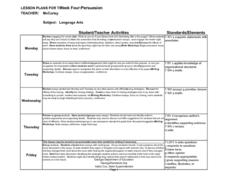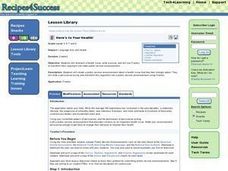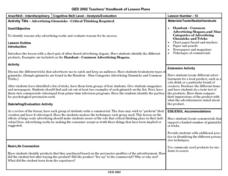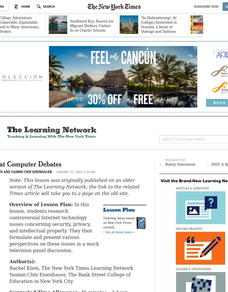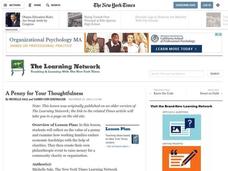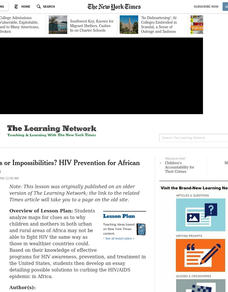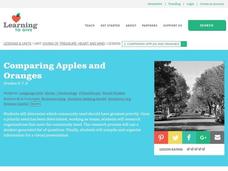Curated OER
See How They Run
Students analyze non-print campaign advertisements for factual and persuasive information. They choose the advertisement they think is the most persuasive and identify the reasons why it is the most persuasive.
Curated OER
Language Arts: Persuasion
Students examine the characteristics of persuasive writing. They identify arguments, supporting details, and discuss how to reorganize and present information in more effective ways. Students compose their own essays and discuss their...
Curated OER
A History of Conflict Resolution and the Jury System
Pupils study the history of the jury system in the United States. They enact a number of different types of trials including trial by jury. They complete a worksheet that compares the trials systems before writing a persuasive essay for...
Curated OER
Creating the "Perfect" Horse
Learners examine horse biology and breeds while investigate the relationship between horses and riders. They research and analyze information found online in order to determine how to produce an all-purpose horse. They write position...
Curated OER
Thinking inside the Box: Dangers of Tanning Beds
Students research their assigned position pro- or con- for the statement "The use of tanning beds by teens should be regulated" and write a short position paper. They participate in a debate concerning the statement. Students write a one...
Curated OER
Plants for Pleasure and Profit
Young scholars study about some of the specimens collected or diagrammed by Lewis and Clark, discuss their usefulness, and rank their importance. They write a persuasive essay detailing the plants they thought the most important.
Curated OER
Here's to Your Health!
Studets research a health issue. They write an essay about the health issue. The create a public service announcement.
Curated OER
Power of Persuasion
Teaching students about persuasion can be a fun experience that involves writing, PowerPoint presentations, and vocabulary building.
Curated OER
Ethical Ways to Acquire and Distribute Fish as a Food Source
Learners complete a variety of activities as they examine the ethics of acquiring and distributing fish as a food source. They touch on the ethics involved in genetically modified salmon, as well.
Curated OER
Tibet and China
Students explore the geography and history of Tibet and China. In this Asian studies lesson, students study the Tibetan situation. In this global issues lesson and conduct research on its ties to China. Students then create political...
Curated OER
Advertising Gimmicks - Critical Thinking Required
Young scholars identify reasons why advertising works, evaluate reasons for its success, and write commercials.
Curated OER
Land of the Rising Guns?
Students discuss the decision after World War II of Japan's to follow a policy of pacifism. After reading an article, they identify the ways Japan is strengthening its military. They watch a video to discover how their Constitution was...
Curated OER
The Great Computer Debates
Learners research controversial Internet technology issues concerning security, privacy, and intellectual property. They formulate and present various perspectives on these issues in a mock television panel discussion.
Curated OER
Classical Greece
Students research historical events in ancient Greece. In this ancient Greece activity, students design a magazine which includes a cover, table of contents, cover story, advertisement and visuals. Students focus on Pericles and...
Curated OER
Land Use and Lawmaking in California
Young scholars design a plan for a housing development in their city. In this house development lesson plan, students observe pictures of land use, research lawmaking, and develop a plan for an environmentally friendly housing...
Curated OER
Does Global Warming Increase the Intensity of Atmospheric Natural Disasters?
Students study global warming by communicating the problem, process and solutions. In this global lesson students use graphs, research and write a critical stance on natural disasters.
Curated OER
A Penny for Your Thoughtfulness
Young scholars reflect on the value of a penny. They examine how working families endure economic hardships with the help of charities. They create their own philanthropic event to raise money for a charity.
Curated OER
Solutions or Impossibilities? HIV Prevention for African Children
Students analyze maps for clues as to why students and mothers in both urban and rural areas of Africa may not fight HIV the same way as those in wealthier countries. They write an essay outlining solutions to the AIDS epidemic.
Curated OER
Monkey See, Monkey Do
Young scholars consider the influence of bullies and map the social ecosystem of their schools. They create lifelines that compare baboon and human development and write an essay that considers the relationship between psychosocial...
Curated OER
Emission Statement
Students investigate the emission of greenhouse gases by industrialized nations. They present their findings in a simulated international global warming conference. They then whether or not the United States should take part in the...
Curated OER
Constitutional Convention
Students engage in a role-playing situation to illustrate the kinds of compromised that were made a teh Constitutional Convention. They write three short 1-2 paragraph arguments and then present their arguments to the class at the...
Curated OER
What Have We Done?
Students investigate the effect of dams on the ecosystem. In this environmental lesson, students read case studies on the Aswan Dam and the Colorado River Basin and construct a T-chart to compare the effects on the region.
Curated OER
The Chinese Expulsion Act of 1880
Students examine the Chinese Expulsion Act of 1880. In this History lesson, students explore the issues of immigration and exclusion surrounding the Chinese Expulsion Act. Students will use a variety of primary sources to write an essay...
Curated OER
Comparing Apples and Oranges
Students understand that many organizations in the community have needs. In this philanthropy lesson, students research pros and cons of a philanthropic organization. Students create a multimedia presentation to show why their...



